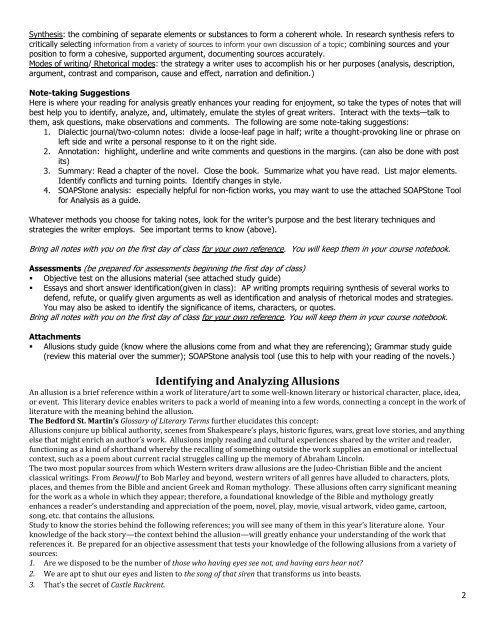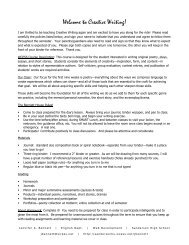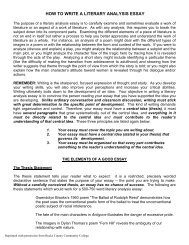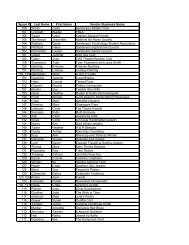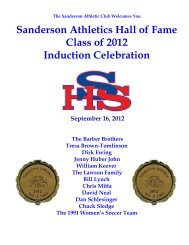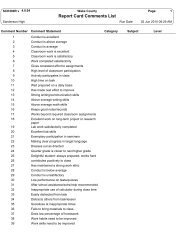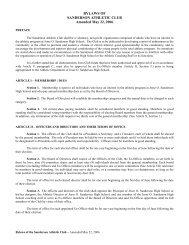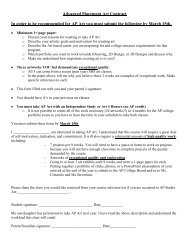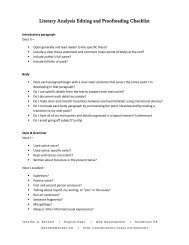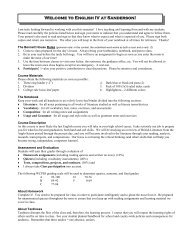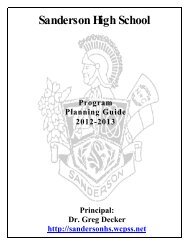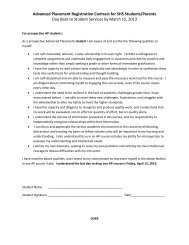Advanced Placement English Language and Composition/AP ...
Advanced Placement English Language and Composition/AP ...
Advanced Placement English Language and Composition/AP ...
You also want an ePaper? Increase the reach of your titles
YUMPU automatically turns print PDFs into web optimized ePapers that Google loves.
Synthesis: the combining of separate elements or substances to form a coherent whole. In research synthesis refers tocritically selecting information from a variety of sources to inform your own discussion of a topic; combining sources <strong>and</strong> yourposition to form a cohesive, supported argument, documenting sources accurately.Modes of writing/ Rhetorical modes: the strategy a writer uses to accomplish his or her purposes (analysis, description,argument, contrast <strong>and</strong> comparison, cause <strong>and</strong> effect, narration <strong>and</strong> definition.)Note-taking SuggestionsHere is where your reading for analysis greatly enhances your reading for enjoyment, so take the types of notes that willbest help you to identify, analyze, <strong>and</strong>, ultimately, emulate the styles of great writers. Interact with the texts—talk tothem, ask questions, make observations <strong>and</strong> comments. The following are some note-taking suggestions:1. Dialectic journal/two-column notes: divide a loose-leaf page in half; write a thought-provoking line or phrase onleft side <strong>and</strong> write a personal response to it on the right side.2. Annotation: highlight, underline <strong>and</strong> write comments <strong>and</strong> questions in the margins. (can also be done with postits)3. Summary: Read a chapter of the novel. Close the book. Summarize what you have read. List major elements.Identify conflicts <strong>and</strong> turning points. Identify changes in style.4. SO<strong>AP</strong>Stone analysis: especially helpful for non-fiction works, you may want to use the attached SO<strong>AP</strong>Stone Toolfor Analysis as a guide.Whatever methods you choose for taking notes, look for the writer’s purpose <strong>and</strong> the best literary techniques <strong>and</strong>strategies the writer employs. See important terms to know (above).Bring all notes with you on the first day of class for your own reference. You will keep them in your course notebook.Assessments (be prepared for assessments beginning the first day of class)• Objective test on the allusions material (see attached study guide)• Essays <strong>and</strong> short answer identification(given in class): <strong>AP</strong> writing prompts requiring synthesis of several works todefend, refute, or qualify given arguments as well as identification <strong>and</strong> analysis of rhetorical modes <strong>and</strong> strategies.You may also be asked to identify the significance of items, characters, or quotes.Bring all notes with you on the first day of class for your own reference. You will keep them in your course notebook.Attachments• Allusions study guide (know where the allusions come from <strong>and</strong> what they are referencing); Grammar study guide(review this material over the summer); SO<strong>AP</strong>Stone analysis tool (use this to help with your reading of the novels.)Identifying <strong>and</strong> Analyzing AllusionsAn allusion is a brief reference within a work of literature/art to some well-known literary or historical character, place, idea,or event. This literary device enables writers to pack a world of meaning into a few words, connecting a concept in the work ofliterature with the meaning behind the allusion.The Bedford St. Martin’s Glossary of Literary Terms further elucidates this concept:Allusions conjure up biblical authority, scenes from Shakespeare’s plays, historic figures, wars, great love stories, <strong>and</strong> anythingelse that might enrich an author’s work. Allusions imply reading <strong>and</strong> cultural experiences shared by the writer <strong>and</strong> reader,functioning as a kind of shorth<strong>and</strong> whereby the recalling of something outside the work supplies an emotional or intellectualcontext, such as a poem about current racial struggles calling up the memory of Abraham Lincoln.The two most popular sources from which Western writers draw allusions are the Judeo-Christian Bible <strong>and</strong> the ancientclassical writings. From Beowulf to Bob Marley <strong>and</strong> beyond, western writers of all genres have alluded to characters, plots,places, <strong>and</strong> themes from the Bible <strong>and</strong> ancient Greek <strong>and</strong> Roman mythology. These allusions often carry significant meaningfor the work as a whole in which they appear; therefore, a foundational knowledge of the Bible <strong>and</strong> mythology greatlyenhances a reader’s underst<strong>and</strong>ing <strong>and</strong> appreciation of the poem, novel, play, movie, visual artwork, video game, cartoon,song, etc. that contains the allusions.Study to know the stories behind the following references; you will see many of them in this year’s literature alone. Yourknowledge of the back story—the context behind the allusion—will greatly enhance your underst<strong>and</strong>ing of the work thatreferences it. Be prepared for an objective assessment that tests your knowledge of the following allusions from a variety ofsources:1. Are we disposed to be the number of those who having eyes see not, <strong>and</strong> having ears hear not?2. We are apt to shut our eyes <strong>and</strong> listen to the song of that siren that transforms us into beasts.3. That’s the secret of Castle Rackrent.2


